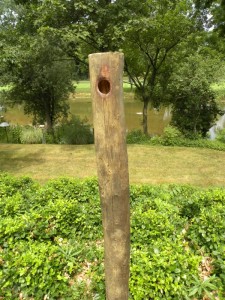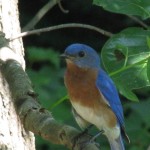What is a Bluebird ?
The Bluebird is a member of the turdidae or thrush family. Three species occur in North America: the Eastern Bluebird, sialia sialias; the Mountain Bluebird, sialia currucoides; and the Western Bluebird, sialia mexicana.
What is the Bluebird’s Range ?
The range of the Eastern Bluebird is east of the Rockies, from southern Canada through the eastern USA down into areas of Mexico, Nicaragua, Bermuda, etc. The range of the Mountain Bluebird includes the western states in the US and western Canadian provinces – wintering into Texas and Mexico. The range of the Western Bluebird includes the western United States and British Columbia. There may be some overlapping of ranges and interbreeding resulting in hybrids.
Where Do Bluebirds Nest ?
All Bluebirds are secondary cavity nesters. They do not excavate their own cavity, but claim an empty cavity created by another bird or animal. They readily accept man-made nest boxes. All species prefer open areas for nesting: meadows, pastures, edges of woodlands, farmland, orchards – all areas of sparse vegetation.
Why Put Up Bluebird Nest Boxes ?
Bluebirds suffered severe decline earlier this century, due to the introduction of non-native House Sparrows and European Starlings in the late 1800’s. In addition to these two species of birds that took over the Bluebirds’ nesting sites and cavities in dead trees, there was loss of wood fences due to farming practice changes, clearing of trees for urban development and the use of chemical pesticides and herbicides which affected their food supply, ie, insects. Bluebirds are highly dependent on those who provide man-made cavities (nest boxes) and active monitoring for their continued survival. You can make a difference by putting up nest boxes AND monitoring them using the information contained in this Q&A and on this website, www.bluebirdconservation.com.
What Can I Do to Attract Bluebirds ?
A Bluebird will nest in a properly designed and constructed house for bluebirds. The entrance hole should be 1-1/2″ round or 1-3/8″ w x 2-1/4″ h if oval. The floor dimensions should be 4″ x 4″ for Eastern Bluebirds or 5″ x 5″ for Mountain and Western Bluebirds. The height from floor to bottom of the entrance hole should be 5″ to 7″. The box should have easy opening for monitoring and cleaning – side or front opening boxes are best. There must be ventilation – small holes or gaps at the top of the box under the roof. The nest box must have drainage holes in the floor. Wood boxes should be made of 3/4″ thick cedar, pine or cypress. The roof should overhang the the entrance hole. The box must have NO perch. If painted, it should be of a light natural color – the inside must not be painted. Although a Bluebird may nest in a poorly designed box – it may be not safe or healthy for the Bluebird family.
Where and How Should I Place a Nest Box for Bluebirds ?
Choose an open area – mowed lawn, field, meadow, orchard – shorter vegetation is preferred. The farther away from brush or trees, the better. Mount the box on a smooth METAL pole (conduit or pipe) – do not use wood poles or trees. The box should be about 5 1/2 feet from the ground. Face the entrance hole away from the prevailing bad weather. Face the entrance hole toward a small tree or bush. Make sure there is a perch, fence post/fence or small tree nearby.
Who Are Competitors for My Bluebird Box ?
Other birds may also use your box. Most of them are also desirable birds: These include, Chickadees, Tree Swallows, Titmice, Wrens, Nuthatches, Great-crested flycatchers and Woodpeckers. Non-desirable birds are House Sparrows and Starlings. Certain mammals may decide to try and make the box their home. These include, squirrels, mice and chipmunks.
What Predators May Bother Bluebirds ?
What Are Some Prevention Methods ?
Predators include the climbing animals: domestic and feral cats, raccoons, opossums, squirrels and snakes. The best defense is to have a predator guard under the box: a metal cone baffle, a section of stovepipe (8″) or PVC (6 or 8″). Also, Noel Guards may be used to protect the entrance hole with heavy guage hardware cloth that is attached to the box. They are 4″ x 4″ and 6″ deep. The guard makes “the reach” into the entrance very difficult. Sharp tangs on the guard discourage snakes from crawling over.
The avian predators are more difficult to predict and prevent. The House Sparrow, a non-native species, will smash eggs and peck nestlings to death. They will even kill Bluebird parents. The House Sparrow MUST NOT be allowed to nest in a Bluebird box ! The introduced European Starling usually cannot fit past the entrance hole in a Bluebird box, but if it gets in, it will also smash eggs and kill birds. Various traps are made to help control these two bird types. In-box traps are used to catch and relocate these avian predators.
What Do Bluebirds Eat ?
Bluebirds are insectivores – insect eaters. They include in their diet some native fruits and berries. They may, especially in times of food shortages, partake of bird feeder offerings such as: suet, raisins, peanut butter mixes, shelled sunflower seeds and nut meats.
What Is A Bluebird Trail ?
A Bluebird Trail is five (5) or more nest boxes over an extended area of open habitat. They are set up to provide housing for more than one family of Bluebirds. When erecting more than one nest box, they need to be spaced about 300 feet apart as bluebirds are territorial and will not nest closer.
What Is Monitoring ?
Monitoring is the periodic checking (looking into) the nest box. One makes note of the stage of nesting (bluebird nest or not), egg count, nestling count and the dates. If there are any problems such as parasites or predation, the problem can be dealt with quickly. Monitoring allows one to prevent or remedy problems that may interfere with the successful nesting of the Bluebird. Never check a box after the nestlings are 14 days or older — they may jump out prematurely and their survival would be in doubt.
What IS the Cycle of Bluebird Nesting ?
Spring arrival from wintering grounds — different in various parts of the country. Courtship begins. Nest building and mating follow. Nests are neat and cup-shaped. They are made of grasses or pine needles. Eggs are laid one a day until there are 3-6 light blue eggs (a small percentage are white). Only the female incubates from 12-14 days. All the eggs normally hatch on the same day. The neslings are born altricial (almost entirley naked). Both parents feed the nestlings. The baby birds are ready to fledge (leave the nest) around 16-21 days after hatching. For 3-4 weeks the parents continue to feed them outside the nest box. The female may re-nest for a 2nd or 3rd time after the juvenile birds continue to grow. The male continues the feeding program.
Can I Put up My New Nest Box in July or August ?
Yes. Even though the nesting season is almost over, it is still a good time to install a new box. Bluebirds and other songbirds can use the box for shelter during cold winter weather. Just having a box in place gives the bluebirds a chance to “check it out” —– and they may remember your box come springtime.
How Should I Clean Out My Bluebird Box ?
I use a putty knife and an old paint brush to clean out the box. This should be done
after each bluebird family fledges. An optional step is to spray inside the box with a
1 part bleach to 10 parts water solution. Allow box to dry with the door open …….
then close the door and box is ready for a new nest.
What Else Can be Done to Enjoy Bluebirds ?
There are other things you may enjoy doing — landscaping for Bluebirds, feeding Bluebirds, providing birdbaths, build a “winter roosting” nest box, make boxes, start a new bluebrid trail or join a state bluebird society, ie, Bluebird Society of Pennsylania, www.thebsp.org.


